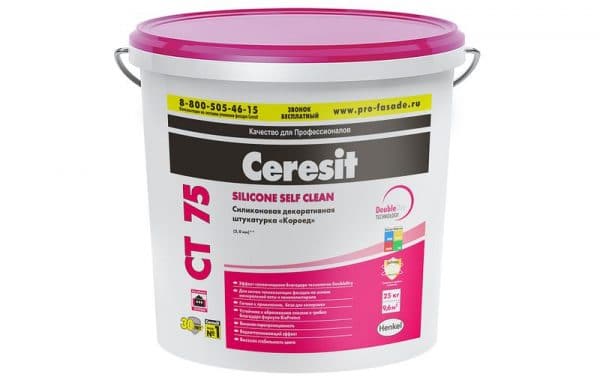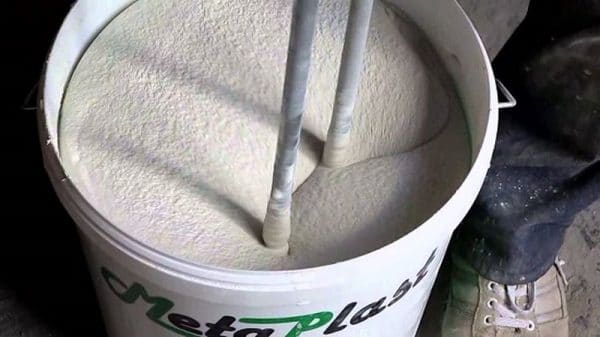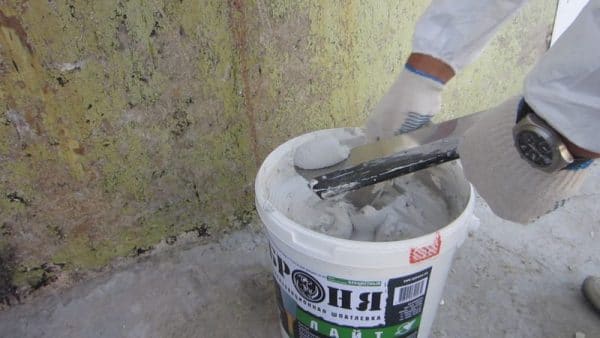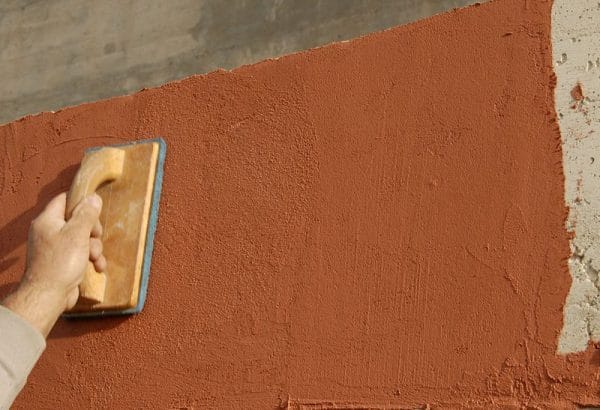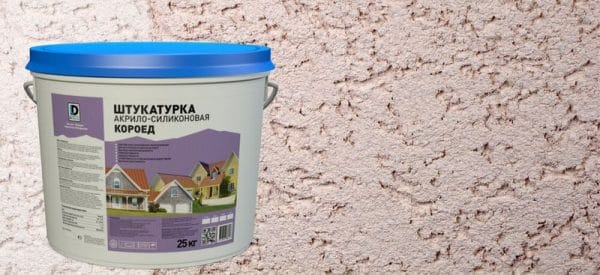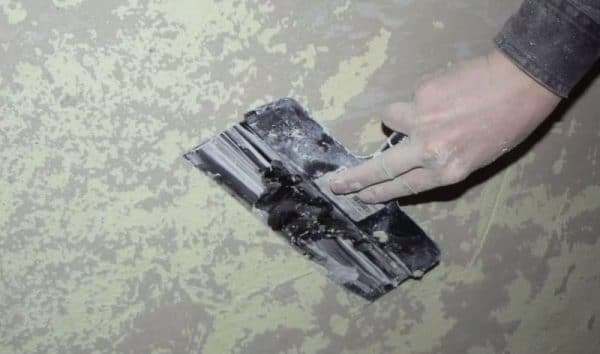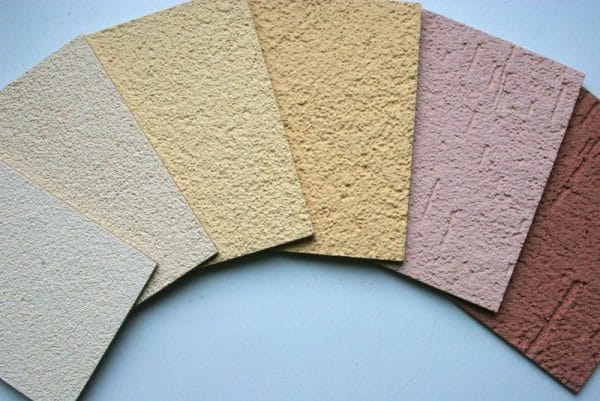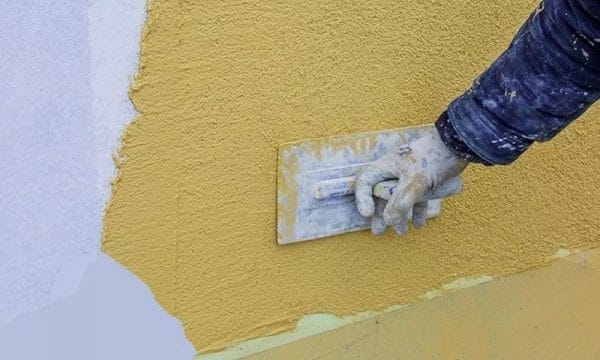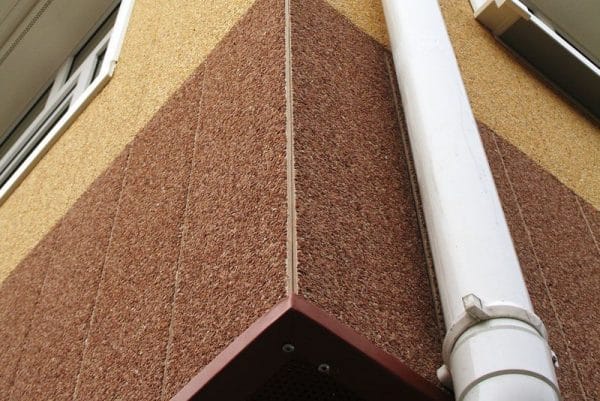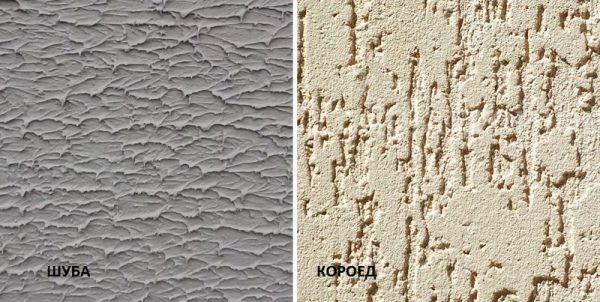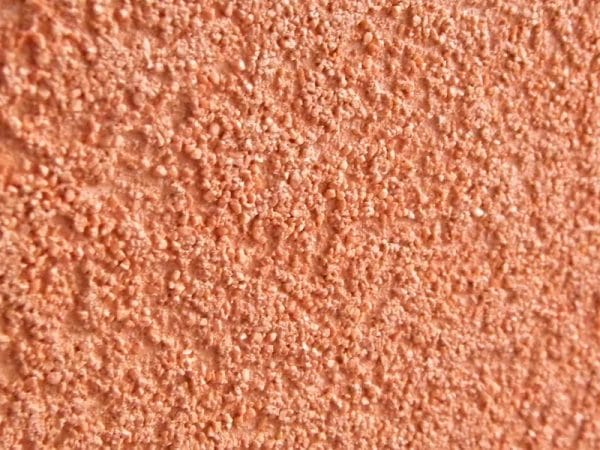To improve the aesthetic qualities of the facade, the plastering technique is often used with various decorative compositions. For example, silicone plaster gives the surface a unique and very stylish look, and also has excellent technical characteristics. High strength, durability and attractiveness allow this material to be used for both outdoor and indoor use.
- What is silicone plaster
- Advantages and disadvantages of the material
- Where plaster is applied
- Types of Silicone Plaster
- Application Technique
- Surface preparation
- Tools for work
- Material application
- Is it possible to paint silicone plaster with silicone paint
- Safety precautions
- Expense of funds
- Silicone Plaster Care
- Selection recommendations
- Manufacturers and cost
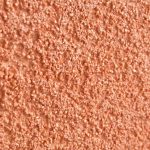
What is silicone plaster
Silicone plaster is a building mixture made on the basis of synthetic silicone resins. Due to the presence of silicone in the composition, the mixture takes on all the properties of the latter: high ductility, the ability to give any shape and excellent adhesion to most building materials. Such characteristics are difficult to find with a different composition, so silicone plaster is unique in its kind.
Silicone-based products are sold in finished form and do not require dilution. Most of the compositions have a grayish or white color, while it is easily tinted. In addition, after drying, the coating can be painted with some types of paints that fit well on silicone.
to contents ↑To improve the technical parameters and impart certain properties, modifiers, additives, antifungal components are also introduced into the composition of the funds.
Advantages and disadvantages of the material
Silicone plaster is suitable for application on concrete, cement, wood, gas silicate slabs, bricks and other materials. An exception is smooth coatings, for example, made of oil paint: with them, the plaster can simply roll off.
This building mixture has many advantages:
- High service life. Silicone serves for many years (from 20) without changing the appearance. It is very resistant to adverse factors and abrasion.
- Elasticity. This property helps not only to quickly and conveniently apply the composition, but also does not allow it to crack, crumble during operation. Also, due to its elasticity, silicone plaster practically does not react to shrinkage of buildings, vibration of walls and other types of deformations.
- Mechanical strength. After hardening, the silicone coating is very difficult to scratch, tear off, knock down, which further increases its demand and reduces the need for periodic updates.
- Moisture resistance. Silicone literally repels moisture, prevents it from absorbing into the base. This helps the outer walls not to spoil from the effects of atmospheric precipitation, but the inner ones - from humidity in the house.
- Vapor permeability. Plaster eliminates the accumulation of condensate, as it helps the walls to breathe. This seriously reduces the risk of mold and allows you to combine silicone with polystyrene, mineral wool and other types of insulation.
- Antiseptic properties and purity.After applying silicone plaster on the walls, you don’t have to worry about keeping them clean. The type of coating will always be attractive, because it repels dust, dirt, and prevents sticking to fats, oils, process fluids. Among other things, silicone resists the appearance of efflorescence on the surface of the walls.
- Possibility of application in any conditions. Silicone does not deteriorate even in extreme situations: with a sharp change in temperature, continuous exposure to water (up to 24–48 hours), constant exposure to ultraviolet radiation.
- Frost resistance. Most quality compounds withstand up to 75-100 cycles of freezing and thawing without loss of properties and attractiveness.
- Fire safety. Silicone plaster belongs to the class G1: it is a low-combustible composition, therefore it practically does not support combustion.
- Environmental friendliness. The material does not contain toxic components, organic solvents, so it can be used indoors and even in children's rooms, hospitals, schools.
Even a beginner can apply plaster to the surface - the material is already ready for work, and for its application no professional tools will be required. An ordinary user will be able to create a coating with an original pattern from a silicone mixture, because the material is sold in different decorative options.
The disadvantages of silicone plaster are also worth noting. Its cost can not be called low, so a complete home decoration can result in a decent amount. The price of acrylic or cement mixtures is much lower. Also remove the annoying coating will not be easy.
The durability and strength of the material remain at a high level, so you have to clean the walls with great effort. To smooth out these disadvantages, it is worth choosing silicone for wall decoration in the case when the repair is not planned to be repeated over the next 20-25 years. Then the material will serve as a very economical and convenient finishing option.
to contents ↑
Where plaster is applied
Silicone compounds are suitable for all materials except very smooth, low porosity. Plaster does not work well on substrates coated with varnishes, oil paints, and also on structures made of metals and alloys. Silicone is best suited for aerated concrete, foam concrete, brick, wood, fiberboard, plywood, asbestos-cement plates, which have many large pores and are characterized by high vapor permeability.
Silicone mixture can be applied to old mineral plasters without varnish and dispersion coatings. It is important that the surface is strong, does not have falling off areas, crumbling pieces.
Most often, silicone-based products are used for processing:
- facades of houses, cottages;
- office buildings;
- industrial buildings;
- architectural forms and compositions;
- interior walls of apartments, cottages.
Types of Silicone Plaster
Depending on the scope of application, the material is divided into the following groups:
- For internal work. Such plaster is suitable for facing walls, niches, panels, for creating frescoes, panels, frames.
- For outdoor use. Plasters of this group are characterized by a higher level of resistance to weathering and frost, as well as increased strength and wear resistance. They are ideal for decorating facades and other outdoor work, and can also serve for wall insulation.
- Universal purpose. Suitable for any type of use, both indoors and outdoors.
Silicone plasters also vary in texture. In stores you can find such varieties of them:
- The bark beetle. Outwardly resembles tree bark, eaten by bugs. When selecting the appropriate color, it can become as close as possible to natural material.
- “Fleece” (“Lamb”). It has original curls, like lamb wool. They are formed by a special type of mashing of the mixture.
- "Fur coat". It gives the surface a rough look, it makes it possible to combine different shades with the transition into each other.
There are also silicone mixtures with the addition of natural stone chips, as a result, the coating will resemble stone. Most often, such material is used for finishing facades.
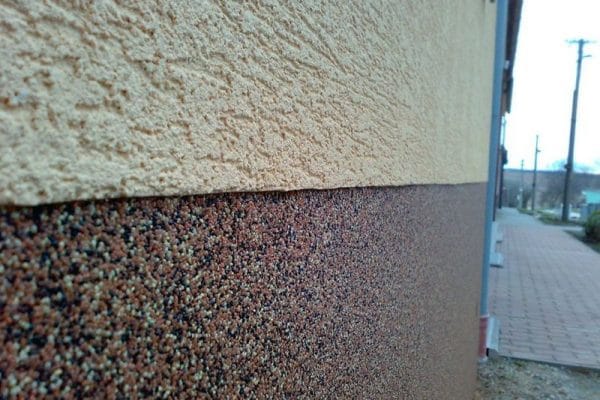
Application Technique
It is necessary to spread the plaster if it is very dry and has become too viscous. In this case, pour a little clean water, then mix the mass with a construction mixer or drill with a nozzle. It is important to carry out all work with silicone-based plaster at a fast pace, since it hardens in a short time. It is easy to apply the mixture: it lays evenly, does not require multiple smoothing.
Surface preparation
First you need to remove all the exfoliated plaster or pieces of another old coating, and align the base. Large, deep defects should be repaired with a cement-sand mixture. Immediately before work, the walls need to be cleaned of dust, primed with a deep penetration primer (preferably also based on silicone).
Walls in new homes are usually prepared this way:
- Small and medium cracks do not close up, since the plaster can easily cope with them.
- If there is a layer of insulation, a reinforcing mesh is placed on it, then a primer, and only then plaster.
- Be sure to eliminate traces of efflorescence, grease stains, soot, biodefeat (fungus, mold).
Before plastering, the foundation must be completely dry.
to contents ↑Tools for work
To apply the plaster, prepare spatulas of different sizes made of plastic or metal, as well as devices for creating the desired texture: building graters, rollers, sponges. For priming, you need a brush or roller, and to assess the evenness of the surface, a level. To complete the drawing or neatly stack different shades of plaster, you need to buy masking tape (for pasting the borders).
Excess material is cleaned with a clean cloth, and tools are washed in containers with water, which are also best prepared in advance. If it is decided to tint the plaster on your own or to introduce stone chips into it, it is worthwhile to perform such actions with the help of a construction mixer, since it is impossible to achieve uniform mixing manually.
to contents ↑Material application
Typically, the solution is applied with a spatula or trowel. Movements are carried out vertically. On a large spatula put a portion of plaster, taking it with a small tool, then transfer the mass to the wall. Smear the composition with a layer of the desired thickness (not less than the size of the grains of the filler, if present). The tool is held at an angle of 60 degrees to the base, reducing the angle at the end of the stroke. Excess composition is removed from the spatula, put back into the bucket.
They start work, as a rule, from the corner of the wall and move in the direction of another angle. After filling a plot of a certain size, smooth the plaster with a grater or other device to give the desired decorative effect. The grater is moved in a circular, direct or chaotic motion, without tearing off the surface. Act quickly to process the freshly applied layer before setting.
If it is not immediately possible to apply the composition to the entire wall, masking tape is glued along the strip of the future joint. The next day, they continue to plaster, without removing the adhesive tape: this will help prevent fresh products from getting on already hardened and eliminate the appearance of an ugly thickening.
In addition to the classic manual application of silicone plaster, other methods are also possible:
- spraying;
- spraying from a gun.
to contents ↑After the plaster dries, the finish painting is carried out if the mixture has not previously been tinted. Use special paints of the same shade or perform drawings, compositions, make interesting combinations of tones.
Is it possible to paint silicone plaster with silicone paint
The plaster is ideally combined with silicone and silicate coloring compounds, which firmly adhere to it, do not flow, lie in an even, smooth layer. Painting work is carried out only after the solution has completely dried on the wall. Nevertheless, in practice they try to pre-tint the plaster so that it immediately has the desired color. This will seriously reduce the complexity of the process, as well as financial costs.
to contents ↑Safety precautions
Silicone plaster for the facade is harmless to humans, but you still need to work with it in compliance with security measures. If the application is carried out in a mechanized way, you must protect your eyes from splashes by wearing glasses. The same is done when processing the composition of the ceilings. Before starting wall cladding, it is important to disconnect the sockets, switches. When the solution penetrates the eyes, they are washed with plenty of water.
to contents ↑Expense of funds
The specific flow rate is determined by the method of applying plaster. Usually it is equal to 2.7-3.3 kg / sq. m. The type of filler, the quality of preparation and the evenness of the wall, the level of user skill can affect the number.
to contents ↑
Silicone Plaster Care
Due to the strength and chemical resistance of the surface, coated with silicone plaster are not demanding in care. Dirt does not stick to the street surface, and most often it is not necessary to wash it. In addition, the outer walls will be washed by rain and will always be in an attractive condition. If necessary, you can wash the walls from a regular hose. The house is completely washed with water lining with detergents.
to contents ↑Selection recommendations
When buying plaster, you need to pay attention to such factors:
- Grain. To obtain a coating with a smooth texture, choose the minimum grain size, and vice versa.
- Hue. A white or grayish mixture can always be tinted directly in a supermarket or specialty store.
- Scope of application. If the material is purchased for outdoor use, it must be frost-resistant.
- Shelf life. The composition must be unexpired, otherwise it will not be able to meet the declared characteristics and properties.
For facade work, the most popular plasters with the texture of bark beetle or fur coat. They combine perfectly with stone, brick. Compositions with stone chips already introduced into them: marble, granite, are no less in demand.
to contents ↑Manufacturers and cost
Among the most famous and high-quality tools that are sold in stores, it is worth indicating the following:
- Weber (Vetonit). Under this brand, several different plasters are made on a silicone and silicate-silicone basis. They are implemented in standard colors, suitable for tinting. They can be stained one day after application. They have a low price and are characterized by frost resistance.
- Ceresit. It produces ordinary and “pebbled” plasters for working inside houses and for decorating facades. Mixtures are suitable for enhancing thermal insulation, can be applied to drywall, fiberboard, OSB, concrete, cement, gypsum.
- Caparol. Stucco allows you to create a beautiful matte finish: smooth, bark beetle, pebble. Under the brand, white and transparent silicone-based compounds are produced, which have increased strength characteristics.
- Kreisel. Mixtures perfectly tolerate humidity, contact with water, regular frosts. Available in several basic colors with different textures.
The average cost of a bucket of silicone plaster weighing 25 kg is 2–2.5 thousand rubles. Mixtures with the addition of stone usually have a higher price (up to 3–3.5 thousand rubles).
Silicone plaster is a product that has appeared on the market recently, but has already managed to win the favor of professionals and users. It has high indicators of quality, appearance and wear resistance, moreover, it is easy to apply.

